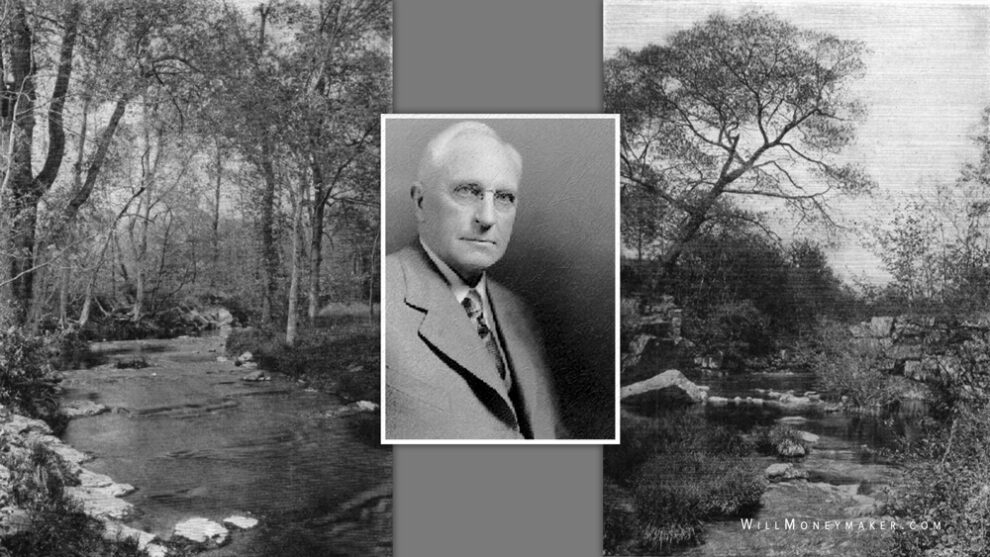His is not a name that you hear all that much these days outside of photographic circles—but there was once a time when his photography graced nearly every home in the United States. This is the story of Wallace Nutting, a photographer, and entrepreneur who would go on to sell millions of prints over the course of his life and spawn a collector’s market that is still going strong to this day. Let me show you about his origins, what led to his photography, and what we all have to gain from his work and his entrepreneurship.
Back to the Beginnings
We’ll start with Wallace’s early life and some of the things that he got into over the years before becoming a photographer—and you’ll soon see that his willingness to dive into anything made him truly one of a kind. Interestingly enough, Wallace was born in a place called Rockbottom in Massachusetts. This was on November 17, 1861, born the second child of Albion and Elizabeth Nutting.
As a boy, Wallace’s father was killed in the Civil War, and this led to him moving around a lot as he bounced between the homes of his relatives. He graduated from an Augusta, Maine high school, then went on to study at several universities including Philips Exeter, Harvard, Hartford Theological Seminary, and the Union Theological Seminary.
His educational career was a stunning one. In 1887, he graduated from Harvard, then went on to earn a Doctor of Divinity at Whitman in 1893 plus an honorary doctorate in humanities from Washington and Jefferson College—though the honorary doctorate came later in life, during 1938.
Wallace’s Adult Life
In 1888, Wallace married Mariet Griswold. The couple never had children, but Wallace’s adult life was nonetheless an active one. Over the years, he served as a minister, artist, antiquarian, author, furniture maker, lecturer—and in later years, photographer.
His early career saw him traveling around the United States as a congregational minister, preaching in places like Providence, Minneapolis, Seattle, and Fryeburg, Maine. However, this calling was cut short when Wallace was only 43. He suffered from a condition called neurasthenia, which is a type of neurological weakness that interferes with movement. After his retirement, he turned to bicycling for his health—and photography.
Booming Business Defines a Region
Wallace’s photographic career was nothing short of extraordinary. It started on those bicycle forays and grew into an empire that not only saw his imagery in millions of households across the United States, but is also largely responsible for the way we tend to think of Connecticut as a picturesque, pastoral place.
At first, he started small, though. After his retirement from ministry, he started into photography and began contributing to magazines and a small print shop. However, by the early 1900s, he’d started his own cottage industry. In 1906, he published a catalog of platinum prints that people could choose, and in following years—1908 and 1912—he published even larger catalogs of photography for sale.
From there, business exploded. His 1912 catalog numbered 97 pages with an incredible 900 images for sale, plus commentary about his body of work. By this point, he was starting to develop an enormous audience, so he hired several young women to hand-color the photographs he was selling.
His home, which he called Nuttinghame, became something of a compound similar to other art-related communes that were forming in places like New York and Aurora. Here, he turned his barn into something of a studio and a factory combined. Colorists painted the images; then, the finished prints moved on to the framing department. In all of this, Wallace became a household name, with his images often referred to by his last name: “Nuttings.”
Nuttings were available in all different sizes, everything from 2×3 prints to 20×30 prints—and popularity soon grew so much that in 1914, he had to move his business out of the converted barn. From here, he took the business to Framingham, Massachusetts, and once set up there, he issued what would be his largest catalog. Released in 1915, it was called the “Expansible” because it was designed so that supplemental inserts could be provided with it.
How much had Wallace’s business grown? When Expansible was published, he said he was making $1,000 per day—which even today is quite a large sum of money!
One of the most unique things about Wallace’s photography? His catalogs had it all. There were entire sections devoted to things like birch trees, blossoms, cathedrals, streams, bridges, mountains and more. The Expansible had 19 different categories, with each print selling for $1.25 to $20, all in different sizes and with different options for frames.
Beyond Photography
If there is one lesson that we can learn from Wallance Nutting, it’s to always keep an open mind and to always look out for opportunities. His photography sales led to so many things. Even today, Nutting prints still hold collectible value—and back then, they were in high demand all over the United States.
And, Nutting took opportunities where he saw them. In some of his photographs, he used furniture as props. That furniture grew to be so popular among the people that enjoyed his photography that he ended up also going into business creating and selling replicas of the furniture in his photography.
He also purchased five different houses, called the Wallace Nutting Chain of Colonial Picture Houses, where many of his photographs were staged. Each of these homes was lovingly restored and outfitted with the furniture that he began to sell as reproductions. There is so much to learn from Wallace Nutting. The entrepreneurial spirit is an inspiration to us all, and his photographs hold such beauty that they were once among the most prominent artworks in American homes. Most of all, whether you apply it to business ventures or to the artmaking process, perhaps the biggest thing we can all learn from Wallace is to always keep an open mind and look out for opportunities as they present themselves.





